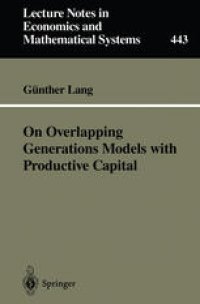
Ebook: On Overlapping Generations Models with Productive Capital
Author: Dr. Günther Lang (auth.)
- Tags: Economics general
- Series: Lecture Notes in Economics and Mathematical Systems 443
- Year: 1996
- Publisher: Springer-Verlag Berlin Heidelberg
- Edition: 1
- Language: English
- pdf
This book was born out of a five-years research at Sonderforschungsbe reich 303 by the Deutsche Forschungsgemeinschaft (DFG) at Rheinische Friedrich-Wilhelms-Universitiit Bonn and was approved as my doctoral thesis by the Rechts-und Staatswissenschaftliche Fakultiit in December 1994. It was my former colleague Wolfgang Peters who had drawn my atten tion to overlapping-generations models and to problems of intergenerational efficiency and distribution. The subtle connection between the latter two has been fascinating me from the very beginning: redistribution of the results of free trade can become necessary from the point of view of efficiency, although no externalities hamper the development of an economy. In spite of being a matured part of economics, neoclassical growth theory had left many questions unsolved, some of them even unrecognized by a large part of our profession. I took up the challenge to contribute to the investigation of some of these thorny problems. One of these issues is the often quoted idea of the inter generational con tract. Although intergenerational transfers can improve intertemporal effi ciency, the design of pension schemes to achieve an improvement of well-being of some generations without hurting that of any other, is not an easy task in an economy with flexible prices. Quite frequently, only interest rate and growth rate are taken into account when deciding on whether a generation wins or looses.
This book examines several unsolved problems in OLG models with productive capital. It extends the well-known Diamond analysis to a model with variable population growth and characterizes dynamically efficient allocations. Then the design of pay-as-you-go pension schemes and government debt to achieve a Pareto-improvement of inefficient growth paths are investigated. Departing from pure efficiency aspects, the book turns to questions of intergenerational fairness and optimal population growth. Finally, introducing a polito-economic model of transfers between generations, conflicting preferences between an infinite sequence of governments are solved for a Markov-perfect equilibrium, providing some important insights into mechanisms of growth and the nature of capital income taxation.